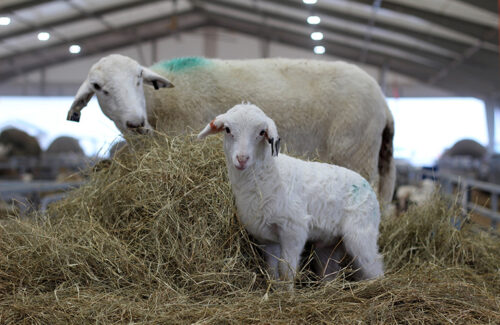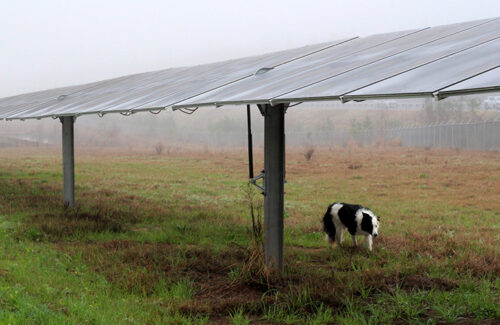The ambitions of the solar project in Houston date from before the existence of Silicon farmThe Southeast Sonne developer who is responsible for bringing the 68-MW Array to Perry, Georgia. A herd sheep graze under the rows of the tracking solar module that covers 697 hectares on Firetower Road in South Houston County, a breed of ewes that have adapted to the environmental conditions of the region for more than two decades.

Lammeren born on the Solar Project site in Houston Live in the barn with their mother Ooien and other sheep from their herd before they graze full-time under the solar array. Kelsey Misbrener/Solar Power World
Development of that tolerance for the hot, wet weather of the southeast started with Roxanne Newton, a consultant for Silicon Ranch and his country management regenerative energy, who bought a small herd of sheep 20 years earlier to graze her country. She soon discovered that her sheep were vulnerable to indigenous parasites, and she switched from a hobbyist shepherd to following and logging the genes of her herd to breed a supply of sheep that can survive in this climate.
“We are worried that all the work I have done for more than 20 years are thrown away,” said Newton. “I hope Silicon Ranch can continue where I had left.”
Jim Malooley, director of Agrivoltaics Operations on Silicon Ranch, said that Newton is the most impactful person for sheeptetic in the southeast. Malooley is also a sheep farmer of the first generation and was accompanied by Newton.
‘[Parasites] Are a threat to every kind, “he said. “The biggest murderer of sheep in this country is not wolves or bobcats – it’s a parasite.”
Their efforts in breeding sheep have played in Houston’s Solar project, the first within the portfolio of Silicon Ranch that has facilities on site to guide sheep through their entire life cycle.
A fabric substances in the open air houses 16 pins with a maximum of 400 birth ewes and lambs just outside the border fence of the solar panel. While Solar Power World Was visited the site, we witnessed one birth. A few minutes after the lamb was born, it was upright and walked it. The Lamb will stay for a short time with his mother, other sheep and guardian dogs, socialize in the pen before he lives full-time and grazes under the solar array.
Houston Solar is built on both sides of Firetower Road, so the herd is routinely transferred from one side of the street to the other or led from one part of the array to the other for planned grazing. Agrivoltaic technicians, the shepherds who retain this herd, maintain a database of every sheep in Houston, who connect the newborn lamb with the ram that injured it and either the beer.
Operations There is a combination of modern practices that have been matched with age -old customs.
“Shepherds and Herding Dogs have worked forever, and we still do that,” said Malooley.

Nigel De Herdershonddrots under the Houston Solar Project in Perry, Georgia. Guardian and shepherd dogs help shepherds to raise and correct the sheep here. Kelsey Misbrener/Solar Power World
The sheep are responsible for the landscape of all 697 hectares of the Houston Solar Project. In 2024, the Agrivoltaics technicians did not have to mow the majority of the country for the first time – only a small clearance around the circumference. Instead, it was fully managed by the sheep itself over five planned grazing.
By using sheep instead of landscape equipment, Silicon Ranch naturally improves the health of the soil under the solar panel and avoiding the use of chemical fertilizers and fossil fuels. Sheep manure works as a natural fertilizer that increases the microbial activities in the soil, making it healthier than before. This process also increases the biodiversity of the country and attracts more local animals to the site. But there is still a lot to learn about the health of the soil and how the herd does it.
“We embrace the strangers in the ground and the feed crops,” said Malooley. “It appears that there are some rhythms in the chaos.”
Regenerative energy was started to implement holistic country management practices on Silicon Ranch Solar Project sites. The Land of Houston Solar was originally zoned for subdivisions. Instead, those nearly 700 hectares retain a topsoil that remains undisturbed due to other developments for the rest of the operational lifespan of the solar project. Keeping the topsoil intact helps with the preservation of water, preventing the removal of precipitation.
“It was really a revelation for us. We are owners of our country. As landowners we have the responsibility to be good stewards of the country, “said Matt Beasley, Chief Commercial Officer of Silicon Ranch.
The Array is composed of Nexpracker NX Horizon-Xtr Solar Trackers with one axle built on “sheep high”, with a front edge of 24 inches, so that the herd cannot reach the first solar panels above. There is extra distance between tracker rows to house farm equipment that can transport sheep or missing bale of hay for additional food when the grass is sleeping.

Silicon Ranch placed an electronic billboard next Interstate-75 to increase the performance of Houston’s solar project. Billy Ludt/Solar Power World
Flint Energies, a regional electric cooperative and member of Green Power EMC, concluded a 15-MW electricity purchase agreement with Houston Solar.
“This is an important part of our power supply,” said Jeremy Nelms, CEO of Flint Energies.
The vast Array borders on Interstate-75, and an electronic billboard that was founded next to the Lambing shed, transfers its awards to commuters that pass by. Silicon Ranch implements sheep herds on 25 of his solar projects, but the arrangement of Houston Solar is not something that can be repeated with every series that possesses.
Houston Solar would not work in this way without the unique efforts of farmers in the southeast. Sheep were once popular cattle under farms in the region, but the population has decreased in the last century.
Malooley said that Houston Solar is an example of how a solar project can offer parallel benefits of both energy and food security. He said this is not something that Silicon Ranch can replicate with every project, because decades made it possible. Instead, the aim is to recognize the individual needs of each project and to find new intersections between agriculture and energy production.


